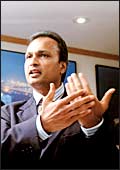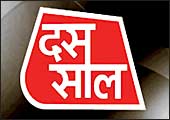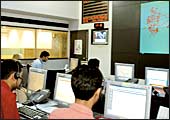|
 Co-owned
by Paris-based Accor Group and Carlson Companies of the US, Carlson
Wagonlit is the world's second-largest travel management company
with $11.5 billion (Rs 50,600 crore) in annual sales. Recently,
the company's coo for Asia Pacific, Berthold Trenkel,
was in India. He spoke to BT's Kushan
Mitra on the booming travel business. Excerpts: Co-owned
by Paris-based Accor Group and Carlson Companies of the US, Carlson
Wagonlit is the world's second-largest travel management company
with $11.5 billion (Rs 50,600 crore) in annual sales. Recently,
the company's coo for Asia Pacific, Berthold Trenkel,
was in India. He spoke to BT's Kushan
Mitra on the booming travel business. Excerpts:
How much has the Indian corporate travel
market grown since 2001?
Indian corporates are travelling a lot more
now, especially abroad. In fact, last year over 70 per cent of
our revenue, which totalled Rs 615 crore, came from international
bookings. This year we expect to do over Rs 850 crore worth of
bookings in India. Overall, in Asia-Pacific, our revenues touched
$1 billion (Rs 4,400 crore) last year, close to 40 per cent growth,
but a lot of that was also due to a post-SARS rebound in travel.
India is currently Asia's fourth largest market after Japan, China
and Australia.
I am sure a lot of your revenues come from MNCs based out of
India.
Not true. While we are the travel agency of
record for many large multinationals like GE, last year 60 per
cent of our revenues came from local companies. We handle the
travel requirements of many large Indian corporates such as Infosys,
Wipro, Satyam and L&T. And while MNCs see a lot of inbound
travel, Indian companies do a lot of outbound travel. As these
companies get more international business, they will travel more.
How is your model different from that
of other travel agencies?
We don't work on a commission basis, which
means we charge a fixed fee for each booking or hotel reservation
and not take 5 per cent off the top of every air ticket. That
means we will try and sell the lowest possible fare. Plus, we
encourage firms that travel a lot to have fixed deals with airlines
and then we become the intermediary between them.
How will low-cost air travel impact corporate
India?
Well, in India unlike in Europe or South-East
Asia, these low-cost carriers fly between major cities. It's not
like Ryanair flying to Frankfurt-Hahn, which is 70 km from downtown,
or Asian LCCs (low-cost carriers) flying to tourist destinations.
However, it is still too early to say what impact it will have,
because there have been problems with cancellations and delays,
and they have very restrictive fares and low frequency. Corporates
need flexibility with travel. You can't do that with one or two
flights a day between Delhi and Mumbai.
Own
Your Own Plane
Can't afford one? No problem. Just buy a part
of it.
 |
| Club One Air's Singh: He'll have you
jetting around |
Another
airline? Groan. But this one's different. Because you will actually
own (partially, at least) the aircraft you're flying in. How?
Buying a jet costs the earth: $4-20 million (Rs 17.6-88 crore),
depending on whether it's pre-owned or brand new. Then, there's
the monthly maintenance bill of Rs 25-40 lakh.
But what if you could buy fractional ownership
in a jet at a fifth or a sixth of these amounts? That's what Manav
Singh, Managing Director, Club One Air, plans to offer. "People
don't have to spend crores buying and maintaining a jet; we will
be their asset managers," he says. The deal is simple. "You
pay a certain amount, say Rs 5-6 crore, to buy a share in a plane
and a few lakhs every month for maintenance. Since the costs are
shared, it becomes that much more affordable," he adds.
In return, you get 160 hours a year in a
luxury seven-seater business jet (a Citation II or Citation XL),
which can fly non-stop to anywhere in the country. All you have
to pay for is the cost of fuel-around Rs 50,000 an hour. "In
the long run, it is cheaper for a company to buy this rather than
charter a small jet at Rs 1.85 lakh an hour," says Singh,
who already has a fleet of three aircraft (Citation jets). He
plans to acquire another two before he begins operations in late
August. His total investment: Rs 75 crore. Singh is thinking big-he
hopes to have a fleet of 30 such jets by the end of next year.
But he concedes that making money in the aviation business is
tough. "I don't think I'll be making money until I have a
fleet of at least 50 aircraft, and that is still a few years away."
Maybe, but the progress of this airline will be interesting to
watch.
-Kushan Bitra
Win
Some, Lose Some
TCS' merger with TIL brings operational synergies,
but at the cost of profit margins.
 |
| TCS' Ramadorai:
Moving up the value chain |
Tata
consultancy services, the country's largest it company, recently
announced the merger of another Tata Group company, Tata Infotech
Limited (TIL), with itself. The swap ratio: 1:2 (or one share
of TCS for every two TIL shares held). Says S. Ramadorai, CEO
and MD of TCS: "The merger brings strong synergies for TCS.
Tata Infotech has a significant presence in the systems integration
space and counts several Fortune 500 companies as clients. The
combined entity can now offer them end-to-end solutions. TCS also
gets a trained team of 3,600 professionals from Tata Infotech.
The merger will lead to greater efficiencies, particularly in
marketing."
Market analysts seem willing to buy that
argument but caution that the merger could impact TCS' margins,
both at the operating and net levels. "The merger will add
Rs 79.8 crore to TCS' bottom line, but its margins will suffer.
If we add the 2004-05 profits of the two companies, TCS' net margin
reduces from 21.1 per cent to 19.9 per cent. This will take time
to correct as TIL's margins are considerably lower than those
of TCS," says Harit Shah, software sector analyst at Quantum
Information Services. Given the flat topline (q-o-q) growth in
the last quarter of 2004-05 and a marginally better 4.83 per cent
sales growth (according to US GAAP) in the first quarter of the
current fiscal, this can be cause for worry. "TCS can offset
the impact of the lower margins by improving operational efficiencies,
getting higher billing rates through better execution of fixed
price projects (FPPs) and improving its business mix in favour
of high-end services like consulting and enterprise business solutions,"
says Shah, adding: "TIL's strength in high-end systems integration
will help TCS move up the value chain; and the acquisition will
help TCS become an end-to-end services provider."
As they say, you win some and lose some.
-Priya Srinivasan
POACHING
ADAE's Bharti Fixation
 Anil
Dhirubhai Ambani Enterprises (ADAE) is raiding Bharti Tele-ventures'
human resource pool. Following in the footsteps of Jai Menon,
who joined ADAE last month as Head of IT, Rajeev Batra (Chief
Architect, Corporate IT and Technology, at Bharti) joined ADAE
as Vice President (IT and Technology). Debabrata Chowdhury, Chief
Technology Officer (Enterprise Services), Bharti, also jumped
ship and joined Anil Ambani as Vice President (Technology Development).
Besides, Nalini Gupta, Chief Products and Marketing Officer at
Bharti, has joined Ambani's office as Marketing Advisor. Anil
Dhirubhai Ambani Enterprises (ADAE) is raiding Bharti Tele-ventures'
human resource pool. Following in the footsteps of Jai Menon,
who joined ADAE last month as Head of IT, Rajeev Batra (Chief
Architect, Corporate IT and Technology, at Bharti) joined ADAE
as Vice President (IT and Technology). Debabrata Chowdhury, Chief
Technology Officer (Enterprise Services), Bharti, also jumped
ship and joined Anil Ambani as Vice President (Technology Development).
Besides, Nalini Gupta, Chief Products and Marketing Officer at
Bharti, has joined Ambani's office as Marketing Advisor.
Telecom industry officials point out that
the Big 3-Bharti, Hutch and Reliance-have the best talent in the
industry. "So it is logical for them to poach from one another,"
they say. This game has been on for a while. Elder brother Mukesh
(when he was Chairman of Reliance Infocomm) had poached Atul Jhamb,
the current head of Reliance Infocomm's Mumbai and Maharashtra
circles, and Inder Bajaj, head of the post-paid business, from
Bharti.
-Krishna Gopalan
A Perfect
10
Hindi news channel pioneer turns 10.
 Aaj
Tak, India's number one news channel, completes 10 years at the
helm of television news business this month. Born as a 20-minute
news capsule on Doordarshan, Aaj Tak had an enormously successful
run on the state-owned channel between 1995 and 2000, when it
went on to become India's first 24-hour Hindi news channel. "People
told us that television news would never work, as audience is
only interested in entertainment not infotainment," recalls
G. Krishnan, CEO of TV Today, the company that runs Aaj Tak (and
Headlines Today), on the challenges that the channel faced back
in 2000. Aaj
Tak, India's number one news channel, completes 10 years at the
helm of television news business this month. Born as a 20-minute
news capsule on Doordarshan, Aaj Tak had an enormously successful
run on the state-owned channel between 1995 and 2000, when it
went on to become India's first 24-hour Hindi news channel. "People
told us that television news would never work, as audience is
only interested in entertainment not infotainment," recalls
G. Krishnan, CEO of TV Today, the company that runs Aaj Tak (and
Headlines Today), on the challenges that the channel faced back
in 2000.
But aggressive, objective and engaging news
reporting in street-lingo Hindi made Aaj Tak, now a Business Superbrand,
a hit with audiences, advertisers and cable operators within just
six months of launch. That helped it stay right at the top even
as the market for 24-hour news exploded and competition came in
from all kinds of players. Says Krishnan: "Apart from maintaining
our viewership lead, we still have more than a fifth of the entire
genre revenues." The genre rakes in Rs 600 crore in annual
advertising revenues.
Aaj Tak has lived with 'Sabse Tez' (which
in popular Hindi means, the fastest) as a defining philosophy,
not just a tag line. "At Aaj Tak, our aim has always been
to capture the changing face of India in the fastest, most imaginative,
memorable and accurate manner. This aim nurtures fearless journalism
and an uncompromising commitment to integrity of news coverage.
And we are proud to have maintained this attitude for 10 years
now. This is a great occasion to celebrate as well as to renew
our commitment to higher levels of achievement for Aaj Tak,"
says Aroon Purie, Chairman and Managing Director of TV Today.
Calling
India
Global telecom OEMs are flocking to India.
 |
| All tuned
in: MNCs are all ears |
To
say that India is a massive market for telecom equipment vendors
is to state the obvious. Manufacturers of every hue want a piece
of the action. And the decision by BSNL (Bharat Sanchar Nigam
Ltd) to float a $5-billion (Rs 22,000-crore) tender for GSM equipment
has only heightened that interest. Chinese major Huawei, for instance,
is seriously considering a manufacturing facility in either Bangalore
or Gurgaon. "We plan to invest over $100 million (Rs 440
crore) over the next three years on a local manufacturing facility
and will also expand our R&D centre in Bangalore," says
Ram Dev Sharma, Head (Product Marketing), Huawei Telecommunications
India. Ericsson, which has had a switching equipment manufacturing
facility in Rajasthan since 1993, has now started manufacturing
GSM radio base stations (RBS) here. This is its fourth RBS manufacturing
facility worldwide; the earlier ones are in Sweden, China and
Brazil.
But French major Alcatel's deal with the
public sector ITI Ltd is perhaps the most significant pointer
to growing multinational interest in India. Says Ravi Sharma,
President, Alactel (South Asia): "We will transfer base station
manufacturing technology to ITI; it will then make these at its
Mankapur plant in up." Also on the anvil is a plan to manufacture
mobile switching exchanges in India. The company has not yet decided
on a location for this unit. The total investment: euro 500 million
(Rs 2,625 crore) in India over the next five years. Sharma, however,
clarifies that this should not be viewed as a direct investment
but as an investment in technology. It's still early days. More
action is expected in the telecom equipment space in the short
to medium term.
-Krishna Gopalan
|




 C
C

 A
A A
A